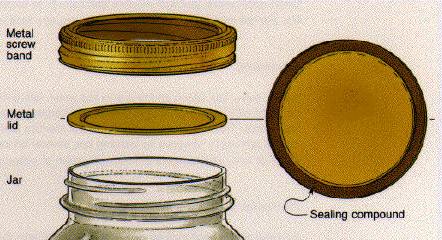
Looking for Reasons Home Canning Jars Don't Seal - and how to fix and prevent it in 2025? Scroll down this page and follow the links. And if you bring home some fruit or vegetables and want to can, freeze, make jam, salsa or pickles, see this page for simple, reliable, illustrated canning, freezing or preserving directions. There are plenty of other related resources, click on the resources dropdown above. If you are having a hard time finding canning lids, I've used these, and they're a great price & ship in 2 days.
If you have questions or feedback, please let me know! There are affiliate links on this page. Read our disclosure policy to learn more.
Reasons Home Canning Jars Don't Seal - and how to fix and prevent it
Jars not sealing is a problem for many new home canners. Once you get the hang of it, you should rarely have a jar fail to seal. My own failure rate is less than 1%.
So, here are typical causes for jars not
sealing
Reasons jars don't seal - and how to prevent it
-
Using nonstandard jars. It's best to use official canning jars and/or lids. (like Ball, Kerr, Golden Harvest, etc)
-
Chipped or uneven rim on jar.
-
Screw rings (also called bands) are rusty or bent, causing poor contact.
-
Bands not screwed down tightly enough before processing. (Turn until you meet resistance, then turn it one-quarter turn.)
-
Rim on jar not clean. (Wipe rim well before putting lid on.)
-
Liquid leaks out of jar during processing, leaving food particles on the sealing edge.
-
Insufficient heat during processing - air not removed from jar so a vacuum seal never forms. (Remove air by inserting a rubber spatula or plastic knife inside the jar gently lift food to remove any trapped air.)
-
Lids were improperly prepared before placing them on rims. (Follow manufacturer's directions to prepare lids. Basically, this means to keep them in a pot of steam hot - but not boiling water to keep them clean and soften the gasket)
-
Pressure canners only: Rapid, forced cooling of a pressure canner can cause a rapid pressure and temperature change inside the canner, causing the liquid to "boil" out of the jars, leaving particles on the sealing rim and unsealing the jars. (Canners should not be forced into cooling rapidly by submerging them in water.)
-
Insufficient processing of raw-packed food - the air may not have been completely driven out of the food, leaving residual air in the jar so the seal does not form.
-
Use of canning procedures which are not recommended, such as open-kettle canning, inversion canning, dishwasher canning, microwave canning and oven canning.
-
Incorrect amount of headspace. (I always maintain at least 1.5 inches of water above the top of the jars.
Reprocessing procedure
If a lid fails to seal on a jar, you have
3 different options:
1. Remove
the lid and check the jar-sealing surface for tiny nicks. If
necessary, change the jar, add a new, properly prepared lid, and
reprocess within 24 hours using the same processing time as
recommended in the recipes..
2. Adjust
headspace in unsealed jars to 1-1/2 inch (to allow for expansion) and
put it in the freezer, upright, instead of
reprocessing.
3. Refrigerate
unsealed jars and eat canned product within seven days of
refrigeration.
Looking for canning equipment and supplies?
Water bath canner with a jar rack
Pressure canners for gas, electric and induction stoves: Presto 23Qt or T-fal 22Qt
Canning scoop (this one is PERFECT)
Ball Blue book (most recent version)
Jars: 8oz canning jars for jams
Find Other types of farms:
Farm markets and roadside stands
Road trips and camping resources
Local Honey, apiaries, beekeepers
Consumer fraud and scams information
Home canning supplies at the best prices on the internet!
Maple Syrup Farms, sugarworks, maple syrup festivals
Environmental information and resources
Farms For Your Event for birthday parties, weddings, receptions, business meetings, retreats, etc.
Festivals - local fruit and vegetable festivals
Get the
most recent version of
the Ball Blue Book
With this Presto 23 quart pressure canner and pressure cooker, you can "can" everything, fruits, vegetables, jams, jellies, salsa, applesauce, pickles, even meats, soups, stews. Model 01781

You can make jams, jellies, can fruit, applesauce, salsa and pickles with water bath canners, like this Granite Ware 12-Piece Canner Kit, Jar Rack, Blancher, Colander and 5 piece Canning Tool Set

